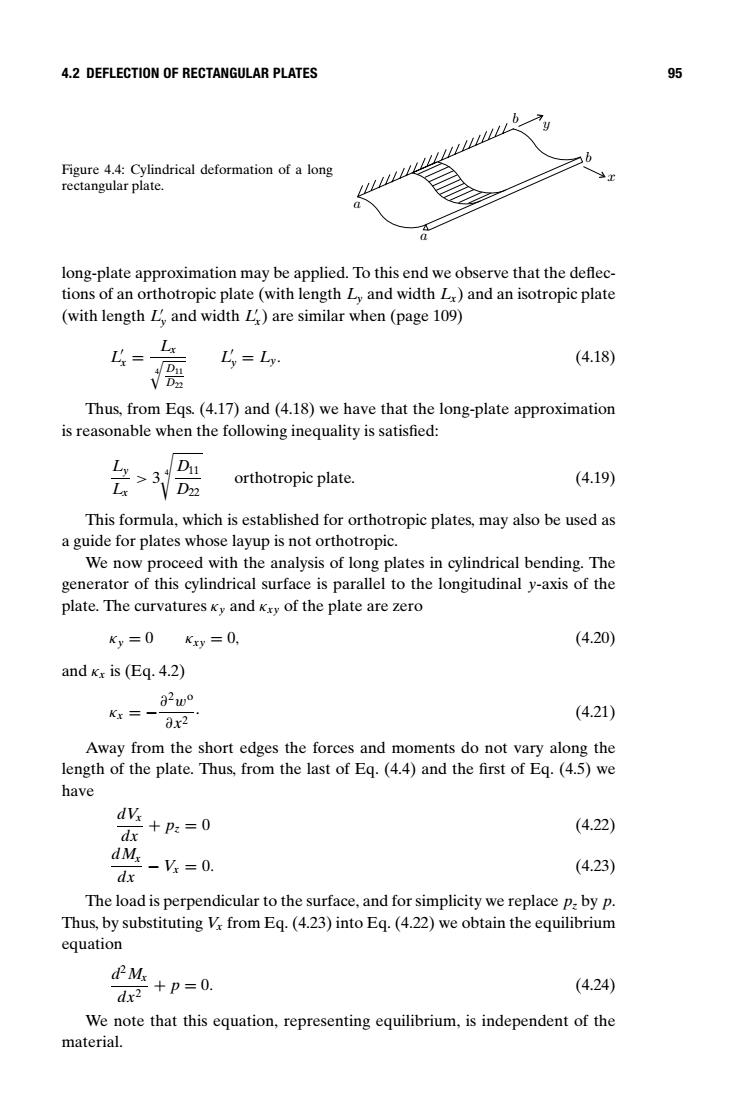正在加载图片...

4.2 DEFLECTION OF RECTANGULAR PLATES 95 Figure 4.4:Cylindrical deformation of a long rectangular plate. long-plate approximation may be applied.To this end we observe that the deflec- tions of an orthotropic plate(with length Ly and width L)and an isotropic plate (with length L,and width L)are similar when (page 109) (4.18) Dit Ly Ly. VDz Thus,from Egs.(4.17)and(4.18)we have that the long-plate approximation is reasonable when the following inequality is satisfied: 2器 orthotropic plate. (4.19) This formula,which is established for orthotropic plates,may also be used as a guide for plates whose layup is not orthotropic. We now proceed with the analysis of long plates in cylindrical bending.The generator of this cylindrical surface is parallel to the longitudinal y-axis of the plate.The curvatures Ky and Kxy of the plate are zero K=0 Kty =0, (4.20) and Kx is (Eq.4.2) 82w° Kx=一 8x2 (4.21) Away from the short edges the forces and moments do not vary along the length of the plate.Thus,from the last of Eq.(4.4)and the first of Eq.(4.5)we have dv d +pz=0 (4.22) dM-V.=0. d (4.23) The load is perpendicular to the surface,and for simplicity we replace p:by p. Thus,by substituting Vr from Eq.(4.23)into Eq.(4.22)we obtain the equilibrium equation d d2+p=0. (4.24) We note that this equation,representing equilibrium,is independent of the material.4.2 DEFLECTION OF RECTANGULAR PLATES 95 a b b a x y Figure 4.4: Cylindrical deformation of a long rectangular plate. long-plate approximation may be applied. To this end we observe that the deflections of an orthotropic plate (with length Ly and width Lx) and an isotropic plate (with length L y and width L x) are similar when (page 109) L x = Lx 4 $ D11 D22 L y = Ly. (4.18) Thus, from Eqs. (4.17) and (4.18) we have that the long-plate approximation is reasonable when the following inequality is satisfied: Ly Lx > 3 4 , D11 D22 orthotropic plate. (4.19) This formula, which is established for orthotropic plates, may also be used as a guide for plates whose layup is not orthotropic. We now proceed with the analysis of long plates in cylindrical bending. The generator of this cylindrical surface is parallel to the longitudinal y-axis of the plate. The curvatures κy and κxy of the plate are zero κy = 0 κxy = 0, (4.20) and κx is (Eq. 4.2) κx = −∂2wo ∂x2 . (4.21) Away from the short edges the forces and moments do not vary along the length of the plate. Thus, from the last of Eq. (4.4) and the first of Eq. (4.5) we have dVx dx + pz = 0 (4.22) dMx dx − Vx = 0. (4.23) The load is perpendicular to the surface, and for simplicity we replace pz by p. Thus, by substituting Vx from Eq. (4.23) into Eq. (4.22) we obtain the equilibrium equation d2Mx dx2 + p = 0. (4.24) We note that this equation, representing equilibrium, is independent of the material.����